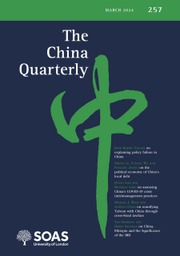Crossref Citations
This article has been cited by the following publications. This list is generated based on data provided by
Crossref.
Hung, Chang-tai
2010.
The Anti–Unity Sect Campaign and Mass Mobilization in the Early People's Republic of China.
The China Quarterly,
Vol. 202,
Issue. ,
p.
400.
Betz, Frederick
2012.
Societal Dynamics.
Vol. 11,
Issue. ,
p.
141.
2012.
China's Security State.
p.
25.
HOWLETT, JONATHAN J.
2013.
‘The British boss is gone and will never return’: Communist takeovers of British companies in Shanghai (1949–1954).
Modern Asian Studies,
Vol. 47,
Issue. 6,
p.
1941.
Wemheuer, Felix
2014.
The Chinese Revolution and “Liberation”: Whose Tragedy?.
The China Quarterly,
Vol. 219,
Issue. ,
p.
849.
Haddad-Fonda, Kyle
2014.
An illusory alliance: revolutionary legitimacy and Sino-Algerian relations, 1958–1962.
The Journal of North African Studies,
Vol. 19,
Issue. 3,
p.
338.
2017.
A Companion to Chinese History.
p.
378.
Cao, Liqun
2017.
The Handbook of Homicide.
p.
467.
Leese, Daniel
2017.
The Cambridge History of Communism.
p.
269.
Cao, Liqun
and
Hebenton, Bill
2018.
China and “La questione criminale” (“the criminal question”): Revolutionary and reformist periods.
International Journal of Law, Crime and Justice,
Vol. 52,
Issue. ,
p.
98.
Strauss, Julia C.
2019.
State Formation in China and Taiwan.
Yang, Dominic Meng-Hsuan
2020.
The Great Exodus from China.
Han, Enze
2020.
The Chinese Civil War and Implications for Borderland State Consolidation in Mainland South-East Asia.
The China Quarterly,
Vol. 241,
Issue. ,
p.
214.
Zheng, Haolan
2021.
Childhoods in Peace and Conflict.
p.
103.
Wang, Greg G.
Doty, D. Harold
and
Yang, Shengbin
2022.
Re-examining the History of Human Resource Development Policy in China: From Local Indigenous Phenomena to Global Human Resource Development Knowledge.
Advances in Developing Human Resources,
Vol. 24,
Issue. 1,
p.
26.
Smith, Tobias
and
Pascoe, Daniel
2022.
Suspended Execution beyond China’s Borders.
Asian Journal of Law and Society,
Vol. 9,
Issue. 1,
p.
133.
Picchiarelli, Silvia
2023.
Voiced and Voiceless in Asia.
p.
101.
Qin, Xuan
and
Owen, Catherine
2023.
The CCP, Campaign Governance and COVID-19: Evidence from Shanghai.
Journal of Chinese Political Science,
Vol. 28,
Issue. 4,
p.
619.
Qian, Xuechao
2024.
Revolutionized life: long-term effects of childhood exposure to persecution on human capital and marital sorting.
Journal of Population Economics,
Vol. 37,
Issue. 1,




